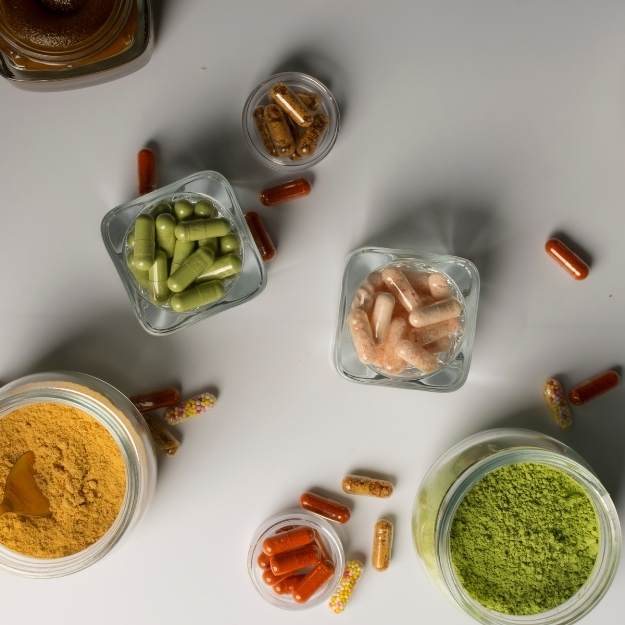
Building muscle is not only crucial for strength and appearance, but also for overall health.
Why is muscle building so important?
Building muscle is crucial not only for strength and appearance, but also for overall health. Active muscles play an essential role in metabolism, hormonal balance, and general well-being. Muscle training releases various hormones that have positive effects on the entire body:
-
Testosterone : Promotes muscle growth and improves recovery
-
Growth hormones (HGH = human growth hormone, IGF-1) : Support cell regeneration and fat metabolism
-
Myokines : Muscle-activated messengers that reduce inflammation and regulate metabolism
-
Oxytocin : Also known as the “love hormone”, it promotes social bonds, reduces stress and improves regeneration
-
Endorphins : Natural painkillers that increase well-being
-
Glucagon : Regulates blood sugar levels and promotes fat burning

A strong muscle not only means strength, but also a close interaction with the nervous system. The neuromuscular system describes the connection between muscles and nerve pathways responsible for movement, strength development, and coordination.
The role of the neuromuscular system
A strong muscle not only means strength, but also a close interaction with the nervous system. The neuromuscular system describes the connection between muscles and nerve pathways responsible for movement, strength development, and coordination.
Regular muscle activation not only trains muscle fibers but also improves neural control. The more active the muscles are, the more efficiently they communicate with the nervous system, which in turn positively influences overall health. This has several benefits:
-
Better motor control and coordination : Strength training improves the neuronal control of the muscles and increases the efficiency of movement sequences.
-
Protection against age-related muscle loss : Studies show that regular exercise (especially strength training) slows down the age-related decline of the neuromuscular system.
-
Supports mitochondrial biogenesis : Increased muscle activity stimulates the formation of new mitochondria, which increases cellular energy production.
-
Increased neuronal plasticity : The brain also benefits from strength and endurance training because it improves the adaptability of nerve cells and thus strengthens cognitive functions.
-
Promotes angiogenesis : Increased exercise stimulates the formation of new blood vessels, which optimizes the oxygen supply to the muscles.
Regular physical activity, especially aerobic and strength training , supports the function of the neuromuscular system and slows its age-related decline. This is essential for the long-term maintenance of muscle strength and function.

Nutrition is an essential component of muscle building. Proper nutrition ensures optimal muscle growth:
-
Protein-rich diet : At least 1.6-2.2g of protein per kilogram of body weight daily.
The ORY Plan – The key to sustainable muscle building
The ORY plan describes a comprehensive method for optimal and sustainable muscle building. It is based on five essential principles: maximum intensity, muscle stimulation, meal planning, targeted nutritional supplementation, and thorough diagnostics . These factors determine how efficiently muscle building progresses and whether the training is successful in the long term.
1. Maximum intensity
Building muscle isn't just about lifting weights, but doing so with maximum intensity. Here are the key aspects:
-
Train with high resistance and low repetitions (6-10 repetitions per set).
-
Focus on progressive overload, meaning continuously increase the training weight.
-
Use the eccentric (negative) phase of the movement to effectively stimulate muscle fibers.
2. Targeted muscle stimulation
Not every repetition automatically leads to more muscle growth. What's crucial is to stimulate the muscles in a targeted manner:
-
Time Under Tension (TUT) : A longer load time per set increases muscle growth.
-
Variation of exercises : Different movement patterns provide new growth impulses.
-
Intensive but compact training sessions : 45-60 minutes per training session is ideal.
3. Meal planning for effective muscle building
Nutrition is an essential component of muscle building. Proper nutrition ensures optimal muscle growth:
-
Protein-rich diet : At least 1.6-2.2g of protein per kilogram of body weight daily.
-
Sufficient carbohydrates : They replenish glycogen stores after training.
-
Healthy fats : Omega-3 fatty acids and unsaturated fats support regeneration.
4. Targeted nutritional supplements: Supplements for muscle and mitochondrial strengthening
In addition to a balanced diet, certain nutritional supplements can support muscle building:
-
Creatine : Increases strength performance and accelerates recovery.
-
BCAA (branched chain amino acids) : Protects muscles and improves protein synthesis.
-
L-Carnitine : Promotes mitochondrial function and supports fat burning.
-
Coenzyme Q10 : Essential for energy production in the mitochondria.
-
Magnesium and zinc : Promote muscle contraction and regeneration.
-
Omega-3 fatty acids : have anti-inflammatory effects and improve recovery.
5. In-depth diagnostics to optimize muscle building
A comprehensive diagnostic assessment helps identify individual deficits and optimize muscle growth. Here are the most important tests:
-
Vitamin and mineral profile : e.g. vitamin D, magnesium or zinc.
-
Amino acid profile : Provides information about individual protein requirements.
-
Hormone status : Testosterone, cortisol and insulin levels influence muscle growth.
-
Inflammatory factors : Elevated levels can slow down regeneration.
-
Digestive analysis and nutrient absorption : Ensure that proteins and fats are effectively processed and absorbed.
-
Liver function : Important for detoxification and nutrient utilization.
-
Mitochondrial function : These “powerhouses of the cells” are crucial for energy production and regeneration.
-
Neurotransmitter and sleep diagnostics :
-
Serotonin and melatonin status : crucial for regeneration and deep sleep.
-
Analysis of the autonomic nervous system : keeping the sympathetic and parasympathetic nervous systems in balance.
-
Sleep quality and deep sleep analysis : Essential for muscle growth and regeneration.
-
The ORY plan as a sustainable method for muscle building
The ORY rule offers a holistic approach for optimal muscle building. It combines essential factors such as maximum intensity, targeted muscle stimulation, thoughtful meal planning, sensible nutritional supplementation, and thorough diagnostics to optimize long-term muscle growth. Those who adhere to these principles can increase their physical performance, improve their health, and sustainably promote their overall well-being. However, patience is key – sustainable muscle building takes time, consistency, and the right strategy.
The neuromuscular system encompasses the interaction between the nervous system and the muscles, particularly the neuromuscular junction (NMJ), which represents a chemical synapse between motor neurons and skeletal muscle fibers. This junction is crucial for converting nerve impulses into muscle contractions.
A healthy neuromuscular system is essential for maintaining muscle strength, mass, and function. Disorders in this system can lead to significant health impairments. For example, diabetic polyneuropathy, a common complication of diabetes mellitus, can lead to muscle atrophy, weakness, and reduced motor performance.
With increasing age, the neuromuscular system degenerates, leading to the development of sarcopenia, an age-related decline in muscle mass and function. This degeneration affects both the structure and function of the NMJ and contributes to reduced muscle strength and endurance.
Regular physical activity, especially aerobic and strength training, can support the function of the neuromuscular system and slow age-related decline. These forms of exercise promote mitochondrial biogenesis, angiogenesis, and neuronal plasticity, which contribute to the maintenance of muscle strength and function.
In summary, the neuromuscular system plays a central role in muscle health and that disorders in this system can have significant effects on overall health and daily life.
References
1. Mechanisms Regulating Neuromuscular Junction Development and Function and Causes of Muscle Wasting.
Tintignac LA, Brenner HR, Rüegg MA.
Physiological Reviews. 2015;95(3):809-52. doi:10.1152/physrev.00033.2014.
Rodríguez Cruz PM, Cossins J, Beeson D, Vincent A.
Frontiers in Molecular Neuroscience. 2020;13:610964. doi:10.3389/fnmol.2020.610964.
Lecce E, Bellini A, Greco G, et al.
The Journal of Physiology. 2025;. doi:10.1113/JP287589.
4. Physiology in Medicine: Neuromuscular Consequences of Diabetic Neuropathy.
Allen MD, Doherty TJ, Rice CL, Kimpinski K.
Journal of Applied Physiology (Bethesda, Md.: 1985). 2016;121(1):1-6. doi:10.1152/japplphysiol.00733.2015.
5. Adaptive Remodeling of the Neuromuscular Junction With Aging.
Deschenes MR, Flannery R, Hawbaker A, Patek L, Mifsud M.
Cells. 2022;11(7):1150. doi:10.3390/cells11071150.
6. The Aging Neuromuscular System and Sarcopenia: A Mitochondrial Perspective.
Rygiel KA, Picard M, Turnbull DM.
The Journal of Physiology. 2016;594(16):4499-512. doi:10.1113/JP271212.
7. The Aging Neuromuscular System and Motor Performance.
Hunter SK, Pereira HM, Keenan KG.
Journal of Applied Physiology (Bethesda, Md.: 1985). 2016;121(4):982-995. doi:10.1152/japplphysiol.00475.2016.
8. Neuroprotective Effects of Exercise on the Aging Human Neuromuscular System.
Allen MD, Dalton BH, Gilmore KJ, et al.
Experimental Gerontology. 2021;152:111465. doi:10.1016/j.exger.2021.111465.
9. https://www.dshs-koeln.de/institut-fuer-biochemie/doping-substanzen/doping-lexikon/w/ Growthshormon-growth-hormone-gh/



Share:
The Power of Lifestyle: Why Our Genes Determine Only 2% of Our Health
Selenium – The underestimated protective shield against cell damage and inflammation